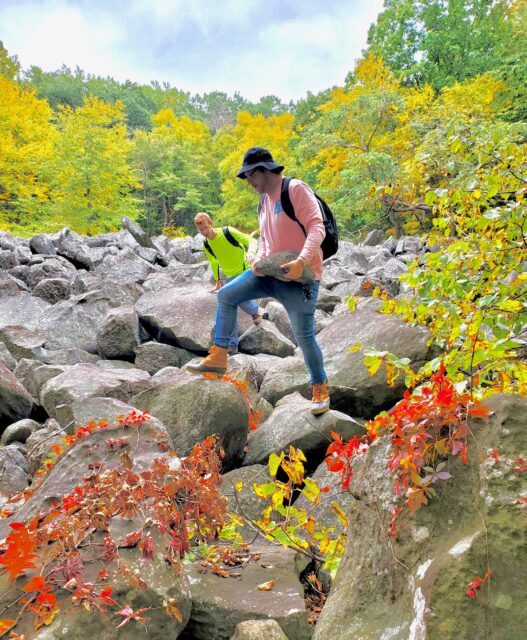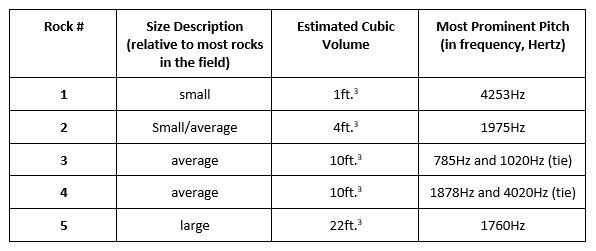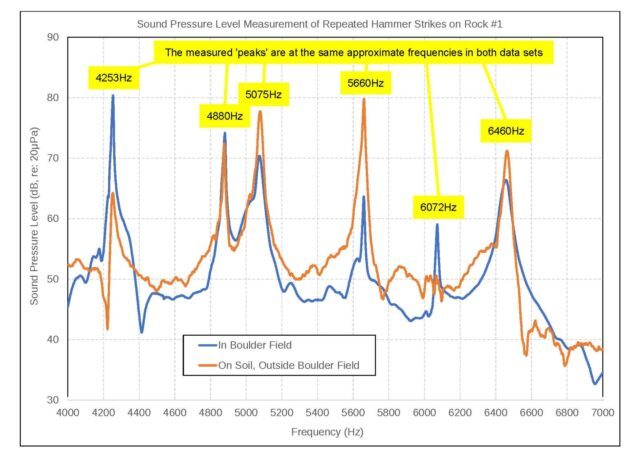Colin Worrich
Senior Consultant

About 35 miles north of Acentech’s Philadelphia office lies Ringing Rocks County Park: charmingly woodsy, easily accessible, and….generally mobbed on weekends. Parking in the cramped dirt lot can be an ordeal, but if you are lucky enough to snag a spot, a short walk through the woods will reward you with a soundscape that doesn’t quite match the landscape:
That’s right, Ringing Rocks County Park contains rocks that ring. A whole field of them, in fact. The boulders stack nearly 10ft. deep in some spots, with hardly any soil, plants, or wildlife to speak of (save for a few very large, very scary spiders). The general idea is to hop around and smack every rock in sight, in search of the ones that resonate the loudest, sound in tune with each other, or remind you of your mom’s dinner bell. Although not all the rocks are ‘ringers’, the best ones are pretty easy to find, having been worn down from decades of taking a literal beating. (Note to potential visitors: Ringing Rocks is strictly BYOH – Bring Your Own Hammer).
Boulder fields themselves are actually not that uncommon. Anyone who’s ever done an alpine hike or climb is familiar with ‘the treeline,’ the point on a mountain ascent where harsh cold, punishing winds, and frequent snowfall stunt long-term forest growth. Without trees, soil accumulation becomes sparse, and is eventually washed away by intense downpours. Water seeping into the exposed bedrock freezes and thaws dramatically, creating cracks and, over millions of years, boulders.
Bucks County, Pennsylvania is hardly a mountaineer’s paradise, but 20,000 years ago it did sport an alpine climate. That’s because it was located just a few miles south of the Wisconsinan Glacier, which covered vast stretches of the northern U.S. and Canada during the end of the Pleistocene. When the glaciers began retreating north about 12,000 years ago, warmer temperatures, forests, and soil moved in, leaving boulder fields as the last visible remains of Pennsylvania’s Ice Age past. Temperate forest growth continues to encroach on the outer edges of these boulder fields, so in another few thousand years this blog post could be badly dated – we’ll update accordingly.
The most likely reason the rocks ring is that they were formed by witchcraft, transported via flying saucer, and positioned by Bigfoot. The internet is full of entertaining supernatural explanations, mostly proclaimed on websites that haven’t been updated since the MySpace era. Acentech’s Board of Directors has yet to approve my proposal for a Paranormal Consulting group, so we’ll leave those theories to others for now.
In terms of scientific studies, there are a few if you dig deep enough. Perhaps the most extensive came in 1970 from a pair of Rutgers University geology professors, who proposed that the ringing rocks are under an unusual amount of tensile stress. In other words, internal forces within the boulders are pulling the constituent molecules away from each other on a microscopic level. Since sound waves travel through solid objects by one vibrating molecule bumping into the next, it’s not unthinkable that greater ‘separation’ between molecules could result in a strange sonic effect. Tightly-packed molecules in a relaxed rock would have greater friction between them, causing rapid dissipation of sound waves, particularly those higher in pitch. On the other hand, ‘stretched out’ molecules in a tense rock would allow higher-pitched sounds to develop and sustain. Think of a ringing rock like a guitar string: when it’s relaxed, it makes a low, dull sound. Add some tension, and you’ve got music.
The Rutgers professors demonstrated this conclusively by bringing a few samples back to their lab. They “sawed the ends and sides from the boulders, leaving only central cores,” then measured the size of the cores over a period of about 3-4 days. In ringers, the cores actually shrunk by about 1/10,000 of an inch per inch of sample length, indicating that they were previously in tension. In non-ringers, the cores didn’t shrink at all. However, when the professors used lab equipment to subject a non-ringer to tension, the core “rang clearly.”
And now comes the unfortunate reckoning for all claims that Ringing Rocks County Park is a mystical, special place – Ringing Rocks County Park is not a mystical, special place. There are actually dozens of ringing boulder fields just like it scattered throughout eastern Pennsylvania and western New Jersey, though most of those that have not been destroyed by human development are either on private property or less-accessible public land. In all cases, they’re made from a relatively common type of bedrock called diabase, which likely formed in this region during the Jurassic period.
The Rutgers team proposed that a certain mineral within diabase expands when mixed with water, in a process called chemical weathering. In other words, repeated rainfall causes the outer surface of the rocks to stretch, creating tension in the core. The lack of soil and shade in these boulder fields means that rainwater runs off and evaporates quickly, allowing chemical weathering and the resulting tension to build up gradually over time. We’re lucky enough to be witnessing these rocks during their prime years, where they’ve got just enough stress in their lives to create beautiful music. Just like people, though, too much stress will cause the rocks to crack up inside – it’s theorized that non-ringers have either reached this point on their own, or broken off from neighboring ringers.

We’re not here to offer a ground-breaking rebuttal of the weathering-tension theory described above, but we did think it was a good use of our time and expensive company equipment to spend an afternoon testing the rocks out for ourselves. The following are some of the myths/claims that came up most frequently during our research:
We took a hammer to a random, evenly-distributed sample of 534 rocks. 167 of them met our criteria for ringing, meaning we can say with 95-percent confidence that the percentage of ringers is 31% (+/-4%).
In reality, labeling a rock a ‘ringer’ or a ‘non-ringer’ is a bit simplistic, as some ring better than others. As shown in the video below, non-ringers tend to produce a dull thud when struck, with only the ‘clink’ from the hammer registering any kind of sustained pitch – in other words, exactly what you’d expect from hitting a normal rock. Ringers usually produce a few loud, clear tones that take several tenths of a second to decay, and sometimes also produce a wide band of complex tones that decay slightly more rapidly.
It was our general observation that rocks on the edge of the field under tree cover tended to be non-ringers, which supports the weathering-tension theory (i.e. the shade from the forest slows rainwater evaporation, surface moisture is retained, chemical weathering proceeds faster, the rocks ‘crack-up’ under internal tension, and ringing ceases).
We took sound measurements while hammering 5 ringers of various sizes. We then analyzed the data to determine the ‘most prominent’ pitch produced by each one, based on both loudness and duration of ring. Our results are presented in the table below:

Ordinary rules of physical acoustics suggest that smaller things resonate at higher pitches. While our smallest rock was indeed the squeakiest, our largest produced a prominent pitch about twice as high as Rock #3, despite being 2.5x its size. In addition, rocks #3 and #4, which were quite similar in cubic volume, produced wildly different pitches.
As demonstrated in the preceding video, no rock produces a single pitch when struck, even those that sound the most ‘bell-like.’ Instead, many frequencies of varying prominence are produced, with little to no relation among them (i.e. they are not multiples, or ‘harmonics’ of the most prominent pitch, as would typically be the case in a musical instrument). We therefore believe that while the size of the rock may play a role in the pitches produced, other factors, including shape, position, and internal tension, are equally as important.
No, there is not some mystical force of awesomeness around the boulder field that permits ringing. (Or maybe there is, we didn’t test for it.) What we did test for was whether the same rock would produce the same prominent pitches when struck in the boulder field as opposed to on a bed of soil outside the field. Check it out:

Even after a 20-minute struggle to transport Rock #1 into the forest, the gang was all there. Interestingly, some of the pitches were amplified by the switch in location, while others were reduced – for example, Rock #1’s most prominent pitch in the boulder field was clearly 4253Hz, while on the soil it shifted up to 5660Hz. See if you can hear the subtle difference:
Setting aside this change in timbre, though, the rock is definitely a ringer, regardless of where it resides.
Pennsylvania is not generally thought of as a land of natural wonders, but Ringing Rocks certainly qualify – a unique collection of geologic, climatic, and acoustic phenomena all colliding at this specific point in time. It’s a shame that it’s been over 50 years since a comprehensive scientific study of these boulders was last undertaken. There are more questions to answer and more myths to bust…
Special thanks to Anthony DeMarte for his help making measurements and lifting heavy things.